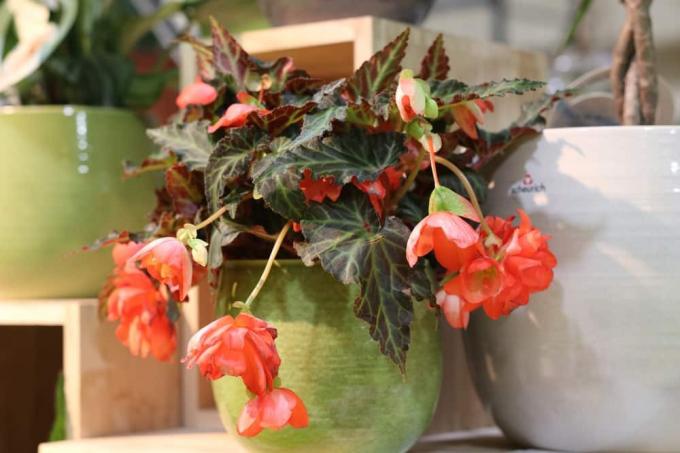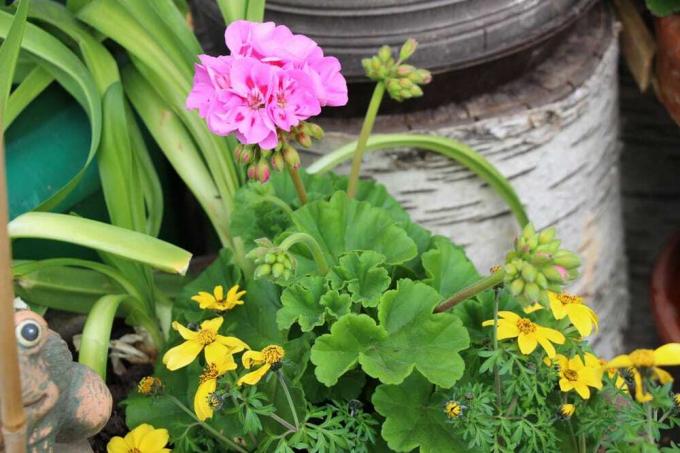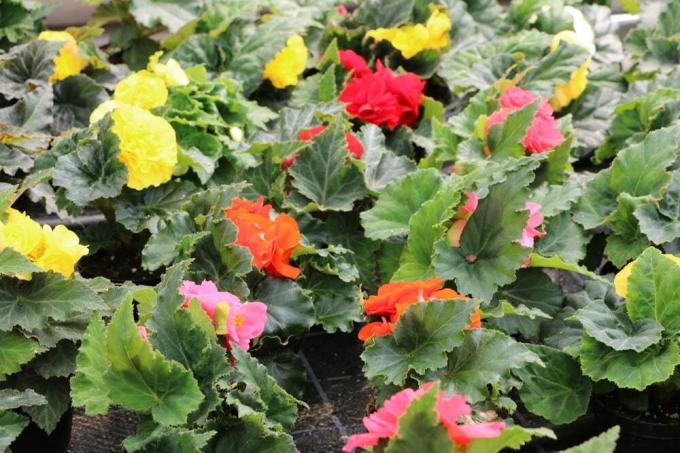

Table of contents
- Location
- substrate
- sowing
- planting
- Pour
- Fertilize
- pruning
- propagation
- wintering
- Diseases
- pests
The Ice Begonia, also known as God's Eye, is a summer bloomer that has many uses for planting. When it comes to care, the plants have few demands, but benefit from nutrient-rich soil.
Location
The location for the begonia should be sunny or partially shaded at most. The flowering plants cannot develop well in the shade, which also applies to the blazing sun and in both cases the leaves in particular suffer. In the blazing sun, the plants require much more care and need to be watered more often.
Windy locations do not bother the begonias, but such locations are often more at risk of frost, which means that the plants die earlier. Hence the name of the ice begonias, as they freeze immediately in sub-zero temperatures, which is clearly shown by the damaged leaves.
substrate
Begonias are not particularly demanding on the soil and normal garden soil is sufficient for them. It is important that the soil is humus and permeable. The latter is a problem, especially when planting in containers. Although the God's Eye also blooms in bad weather, it does not tolerate waterlogging and the roots begin to rot.
When planting in a pot or window box, the bottom layer should always provide drainage. Expanded clay or lava granules, for example, are suitable as drainage.
A notice:
You can loosen up heavily compacted soil outdoors by mixing in sand and fine gravel. Coarse organic material such as year-old compost also helps to loosen the soil and provides nutrients as it decomposes.
sowing
Begonias should be sown as early as January. The seeds should be in the ground by March at the latest. Otherwise it can happen that the plants hardly bloom and freeze before then, unless you overwinter them. Germination can take up to 14 days at a temperature of around 24°C. Ice begonias need light to germinate and should not be covered with soil.

When sowing, you should consider the following points:
- use lean seed soil for germination
- Use indoor greenhouse to reduce the risk of dehydration
- Gently press seeds
- use only a spray bottle to water
- Set up the indoor greenhouse in a bright location
As soon as the young plants are strong enough, they can be transplanted. To do this, carefully lift the young plants out of the ground with a stick or fork. As a follow-up substrate, you can use a mixture of half potting soil and half potting soil. The first substrate when pricking out should not be too rich in nutrients, as this reduces root formation. The young plants only need to be watered moderately until they are planted in May, which also promotes root formation.
planting
From mid-May, after the ice saints, you can plant the ice begonia outdoors. Before that, the risk is too great that late frosts will cause lasting damage to the plants. Before the young plants go outdoors permanently, you should get them used to it about two weeks beforehand, otherwise the leaves could be damaged by the sun.
For the first week outdoors, place the god eyes in a sheltered spot that gets a maximum of one to two hours of sun. From the second week you can put them in the sun for several hours, but you should protect them a little during midday.
The planting time outdoors is only limited by the frost. You can still plant ice begonias in August, but they will die off outdoors with the first frost.
Pour
The polar begonia has very thick and fleshy leaves in which it can also store some water. Although the plants like a constantly slightly moist location, they also forgive it if the substrate dries out for a long time. Therefore, they are also ideal plants for graves, where daily watering is not possible.
What the ice begonias cannot tolerate is waterlogging. Therefore, always water regularly but only moderately. For cultures in pots, you should fill up the saucer as much as possible. Anything that cannot be absorbed by the substrate within an hour, empty it again.
The god's eye prefers tempered water when watering. It is sufficient if you leave the watering can filled with water next to the plants for half a day. As a result, they have the ideal temperature adapted to the location. Water preferably in the morning when the plants benefit most from watering. Ice begonia is lime tolerant, but like many other flowering plants, prefers neutral rainwater.
A notice:
When watering, make sure that you water on the ground if possible and that the leaves do not get wet. Single drops can act like a magnifying glass and damage the leaves.
Fertilize
Before planting, you can incorporate organic fertilizer such as compost into the soil. During the flowering period, the ice begonias benefit from an organic fertilizer. You should avoid mineral fertilizers for the plants. If the ice begonia is in full bloom, you should preferably use a liquid fertilizer for flowering plants. This promotes long flowering and the formation of new buds.

pruning
When it rains continuously, the flowering of the ice begonia is short-lived and especially varieties that have white flowers look ugly. You can always remove faded flowers, but it is not a must. The dead flowers and leaves eventually fall to the ground and rot there. You should remove broken leaves or shoots as soon as possible. They only cost the plant energy unnecessarily, which limits the formation of new shoots.
propagation
The propagation of an ice begonia is usually only possible with cuttings. Seeds from the trade are hybrid seeds and there is no guarantee that the next generation will have the same characteristics. In addition, hybrid plants hardly or rarely form seeds that are also germinable. The propagation of cuttings is usually very successful, because you can simply root the shoots in the water. If you need several plants for a bed, you should take cuttings as soon as possible, as it takes some time for them to develop into strong plants.
wintering
The god's eye would be perennial, but is rarely overwintered, since the plants are usually offered cheaply in the trade. However, it is possible to overwinter the plants as cuttings, for example, since they take up little space. If you want to overwinter the whole plant, you have to dig it up in September and put it in a pot.
The ice begonia makes the following demands on the winter quarters:
- bright
- Frost free
- Temperatures around 15°C
- no draft
In the winter quarters you can completely do without fertilization. Only from mid-April do you slowly start with a light fertilization, so that the formation of shoots is promoted. The plants also only get water very sparingly and, as with fertilization, increase the frequency of watering from mid-April. In the winter quarters you should occasionally check for pests such as spider mites.
As soon as the planting season begins, the plants from the winter quarters can also go outdoors again permanently. However, get them used to the sunlight like the young plants. In addition, you should slowly get the plants used to a higher temperature in the winter quarters. This also promotes the formation of shoots.
Diseases
While ice begonias tolerate cool temperatures and rain, the combination of heat and humidity is not good for the plants. If it rains continuously in summer, then gray mold and powdery mildew can form on the leaves. Fungal diseases can quickly spread over the entire plant and should be combated quickly.

Tips for controlling and preventing fungal diseases:
- Cut off affected areas with a clean knife
- Dispose of shoots with fungal diseases in the residual waste
- Protect plants from rain
- water only near the ground
- use a commercially available fungicide if the infestation is severe
If the fungal infestation cannot be combated by removing the shoots, do not hesitate to use a fungicide on ornamental plants. There are effective biological preparations on the market that you can use to prevent spread.
Occasionally, the ice begonia also causes root rot. This is caused by too much water or waterlogging. If the root rot is already too far advanced, the plants can usually no longer be saved. In an early stage, quick repotting in a dry substrate can help. Avoid watering for the first week or two.
pests
The ice begonias are not susceptible to pests. Only spider mites can occasionally appear in the winter quarters if the humidity is too low. However, this problem can usually be easily remedied by spraying the plants occasionally or by placing a large bowl of water next to them. The ice begonia even has the advantage that it itself forms a barrier against a dreaded pest in the garden. Snails avoid the ice begonias and are therefore also very suitable as border plants to protect vegetables or other ornamental plants.
 garden editorial
garden editorial I write about everything that interests me in my garden.
Learn more about balcony plants

Begonia location: 3 important criteria
Begonias are easy-care plants. However, so that they can thrive and you can actually enjoy them, the location must be right. And that means above all: no direct sunlight, but shade or semi-shade. In addition, the soil should be as moist as possible.

Blue fan flower, Scaevola aemula: care from A - Z
Are you looking for an easy-care and robust flower for the balcony? Then the blue fan flower might just be the right plant for you!

16 popular hanging plants and how to care for them
Hanging plants aren't always a sad sight. At least not when nature intended it that way. Their tendrils weave a new dress on boring balcony walls in no time. Whether fast-growing, green, colorful or just easy to care for, every wish will be fulfilled.

13 balcony plants for sunny south-west balconies balcony flowers
A balcony with leafy or flowering plants delights both the heart and the eye. However, not every balcony plant is suitable for every balcony, because every plant makes specific demands on the location. We have put together for you which plants are particularly suitable for a south-west balcony.

Scented geraniums: care, propagation and overwintering scented geranium
Is it the lush growth? The brightly colored flowers? Or is it its beguiling scent that makes the scented geranium our favourite? Does she have any other trump cards? Yes! As beautiful as she is, she is also undemanding. Your care succeeds!

Driving tuberous begonias in 14 steps - prefer begonias
The flowering period of the tuber begonia starts comparatively late. Night frosts and slow growth are the two main causes. More time and heat are the solution. Propelling the tubers forward is therefore a tried and tested method of enjoying the splendor of color earlier and for longer.


